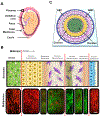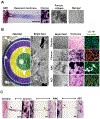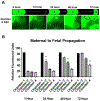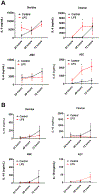Modeling ascending infection with a feto-maternal interface organ-on-chip
- PMID: 33112317
- PMCID: PMC7815379
- DOI: 10.1039/d0lc00875c
Modeling ascending infection with a feto-maternal interface organ-on-chip
Abstract
Maternal infection (i.e., ascending infection) and the resulting host inflammatory response are risk factors associated with spontaneous preterm birth (PTB), a major pregnancy complication. However, the path of infection and its propagation from the maternal side to the fetal side have been difficult to study due to the lack of appropriate in vitro models and limitations of animal models. A better understanding of the propagation kinetics of infectious agents and development of the host inflammatory response at the feto-maternal (amniochorion-decidua, respectively) interface (FMi) is critical in curtailing host inflammatory responses that can lead to PTB. To model ascending infection and determine inflammatory responses at the FMi, we developed a microfluidic organ-on-chip (OOC) device containing primary cells from the FMi (decidua, chorion, and amnion [mesenchyme and epithelium]) and collagen matrix harvested from primary tissue. The FMi-OOC is composed of four concentric circular cell/collagen chambers designed to mimic the thickness and cell density of the FMi in vivo. Each layer is connected by arrays of microchannels filled with type IV collagen to recreate the basement membrane of the amniochorion. Cellular characteristics (viability, morphology, production of nascent collagen, cellular transitions, and migration) in the OOC were similar to those seen in utero, validating the physiological relevance and utility of the developed FMi-OOC. The ascending infection model of the FMi-OOC, triggered by exposing the maternal (decidua) side of the OOC to lipopolysaccharide (LPS, 100 ng mL-1), shows that LPS propagated through the chorion, amnion mesenchyme, and reached the fetal amnion within 72 h. LPS induced time-dependent and cell-type-specific pro-inflammatory cytokine production (24 h decidua: IL-6, 48 h chorion: GM-CSF and IL-6, and 72 h amnion mesenchyme and epithelium: GM-CSF and IL-6). Collectively, this OOC model and study successfully modeled ascending infection, its propagation, and distinct inflammatory response at the FMi indicative of pathologic pathways of PTB. This OOC model provides a novel platform to study physiological and pathological cell status at the FMi, and is expected to have broad utility in the field of obstetrics.
Conflict of interest statement
Figures







Similar articles
-
Molecular mechanisms of environmental toxin cadmium at the feto-maternal interface investigated using an organ-on-chip (FMi-OOC) model.J Hazard Mater. 2022 Jan 15;422:126759. doi: 10.1016/j.jhazmat.2021.126759. Epub 2021 Aug 2. J Hazard Mater. 2022. PMID: 34391970 Free PMC article.
-
Extracellular vesicle mediated feto-maternal HMGB1 signaling induces preterm birth.Lab Chip. 2021 May 18;21(10):1956-1973. doi: 10.1039/d0lc01323d. Lab Chip. 2021. PMID: 34008619 Free PMC article.
-
Feto-Maternal Interface Organ-on-Chip: A New Technology to Study Ascending Infection.Methods Mol Biol. 2024;2781:105-117. doi: 10.1007/978-1-0716-3746-3_10. Methods Mol Biol. 2024. PMID: 38502447
-
Organ-On-Chip Technology: The Future of Feto-Maternal Interface Research?Front Physiol. 2020 Jun 30;11:715. doi: 10.3389/fphys.2020.00715. eCollection 2020. Front Physiol. 2020. PMID: 32695021 Free PMC article. Review.
-
Induction of pro-inflammatory cytokine gene expression and apoptosis in human chorion cells of fetal membranes by influenza virus infection: possible implications for maintenance and interruption of pregnancy during infection.Med Sci Monit. 2005 Jan;11(1):RA7-16. Med Sci Monit. 2005. PMID: 15614205 Review.
Cited by
-
Serum calcium level at 32 weeks of gestation could be applied as a predictor of preterm delivery: a retrospective study.Eur J Med Res. 2024 Aug 1;29(1):400. doi: 10.1186/s40001-024-01984-4. Eur J Med Res. 2024. PMID: 39090755 Free PMC article.
-
Construction and imaging of a neurovascular unit model.Neural Regen Res. 2022 Aug;17(8):1685-1694. doi: 10.4103/1673-5374.332131. Neural Regen Res. 2022. PMID: 35017415 Free PMC article. Review.
-
Testing of drugs using human feto-maternal interface organ-on-chips provide insights into pharmacokinetics and efficacy.Lab Chip. 2022 Nov 22;22(23):4574-4592. doi: 10.1039/d2lc00691j. Lab Chip. 2022. PMID: 36322152 Free PMC article.
-
Modeling ascending Ureaplasma parvum infection through the female reproductive tract using vagina-cervix-decidua-organ-on-a-chip and feto-maternal interface-organ-on-a-chip.FASEB J. 2022 Oct;36(10):e22551. doi: 10.1096/fj.202200872R. FASEB J. 2022. PMID: 36106554 Free PMC article.
-
Organic Anion Transporting Polypeptide 2B1 in Human Fetal Membranes: A Novel Gatekeeper for Drug Transport During Pregnancy?Front Pharmacol. 2021 Dec 20;12:771818. doi: 10.3389/fphar.2021.771818. eCollection 2021. Front Pharmacol. 2021. PMID: 34987396 Free PMC article.
References
Publication types
MeSH terms
Substances
Grants and funding
LinkOut - more resources
Full Text Sources

